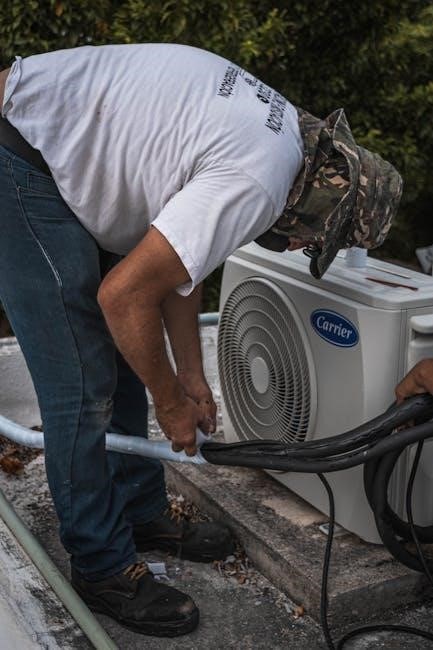ACCA Manual D is the ANSI-recognized standard for residential duct design, ensuring efficient HVAC systems by balancing airflow and optimizing duct layouts․
It provides updated guidance on VAV systems, flexible ducts, and equivalent lengths, helping designers create energy-efficient and cost-effective solutions for home comfort․
What is Manual D?
ACCA Manual D is the ANSI-recognized standard for designing residential HVAC duct systems․ It provides detailed procedures for sizing ducts to ensure balanced airflow and optimal system performance․
Developed by the Air Conditioning Contractors of America (ACCA), Manual D is part of a four-step HVAC design process, following load calculations and equipment selection․ It focuses on duct sizing, layout, and material selection to achieve energy efficiency, comfort, and cost-effectiveness in home heating and cooling systems․
Importance of Manual D in Residential HVAC Design
Manual D is crucial for ensuring efficient and effective residential HVAC system performance․ It provides standardized methods for duct sizing and layout, ensuring balanced airflow and optimal heating and cooling distribution․
By following Manual D, designers can create systems that comply with ACCA standards, reducing energy consumption and improving comfort․ Its guidelines help avoid common design flaws, ensuring systems operate efficiently and effectively for homeowners․

Key Concepts of HVAC Manual D
Manual D outlines essential principles for duct system design, focusing on airflow balance, proper sizing, and material selection to ensure efficient HVAC performance in residential settings․
Overview of Residential Duct Design
Residential duct design involves sizing and layout of duct systems to ensure balanced airflow, proper heating, and cooling distribution․ Manual D provides standardized methods for calculating duct sizes, considering factors like air velocity, friction losses, and system performance․ It also addresses material selection, such as flexible ducts, and offers best practices for installation to minimize leaks and energy losses, ensuring efficient and reliable HVAC operation in homes․ Proper design enhances comfort and reduces energy costs significantly․
The Role of Manual D in the HVAC Design Process
Manual D serves as a critical guide in the HVAC design process, offering standardized procedures for duct system design․ It ensures that duct layouts and sizes are optimized for energy efficiency and performance․ By following Manual D, designers can accurately calculate duct dimensions, account for airflow dynamics, and integrate components like junction boxes and flexible ducts․ This ANSI-recognized standard streamlines the design process, helping contractors deliver systems that meet comfort and energy requirements while minimizing installation errors and operational costs․
Essential Principles of Duct System Design
Duct system design relies on balancing airflow, managing pressure drops, and ensuring proper sizing for optimal performance․ Manual D emphasizes the importance of duct material selection, insulation, and sealing to minimize energy losses․
Key principles include maintaining consistent velocities, avoiding excessive duct lengths, and ensuring tight connections to prevent leaks․ Proper design also considers load calculations, equipment compatibility, and space constraints to achieve efficient and quiet system operation․

ACCA Standards and Manual D
ACCA standards provide authoritative guidelines for HVAC design, with Manual D being integral to the process․ Its ANSI recognition ensures credibility and reliability in duct system design․
Manual D offers standardized methods for sizing ducts, balancing airflow, and optimizing performance across various materials, ensuring efficient and balanced HVAC systems in residential settings․
What Are ACCA Standards?
ACCA standards are authoritative guidelines for HVAC system design, installation, and maintenance․ They provide industry-accepted procedures validated by ANSI recognition, ensuring quality and efficiency․
These standards are developed by industry experts to address various aspects of HVAC, including load calculations, duct design, and system performance, helping contractors deliver optimal home comfort solutions․
Significance of ANSI Recognition for Duct Design
ANSI recognition ensures that ACCA Manual D meets rigorous industry standards, providing a trusted framework for duct design and sizing across all materials and systems․
This recognition validates the manual’s procedures, ensuring designs are accurate, efficient, and reliable, which is critical for achieving optimal HVAC performance and energy efficiency in residential settings․
Duct Sizing and Calculation Methods
Manual D provides precise methods for sizing ducts, ensuring optimal airflow and system performance through detailed calculations and material-specific guidelines․
How to Calculate Duct Sizes for Optimal Performance
Calculating duct sizes involves determining airflow rates, pressure drops, and system requirements․ Manual D provides detailed procedures for sizing supply and return ducts, ensuring balanced airflow․ Factors like duct material, insulation, and layout influence calculations․ Using ACCA’s tables and equations, designers can optimize duct dimensions for efficiency․ Proper sizing ensures minimal energy loss, consistent temperatures, and reduced noise․ Accurate calculations are crucial for achieving optimal HVAC performance and comfort in residential settings․
Best Practices for Duct Sizing in Residential Systems
Best practices for duct sizing include adhering to Manual D guidelines, considering system load calculations, and ensuring proper sealing․ Ducts should be sized to maintain optimal airflow velocities, typically between 600-900 CFM per ton․ Proper fitting selection and minimizing bends reduce pressure drops․ Flexible ducts require careful handling to prevent sagging and compression․ Regular testing for leaks and ensuring insulation meet standards are critical․ These practices ensure efficient, quiet operation and consistent indoor air quality in residential HVAC systems;

Duct System Layout and Design
Proper duct layout ensures balanced airflow, minimizing bends and elbows to reduce pressure drops․ Adhering to Manual D standards ensures efficient system performance and optimal energy use․
Load Calculations and Their Impact on Duct Design
Load calculations determine the heating and cooling requirements for each room, directly influencing duct size and airflow․ Manual D emphasizes accurate load assessments to ensure balanced airflow․
By evaluating factors like insulation, windows, and internal heat sources, load calculations guide duct design, ensuring optimal system performance and energy efficiency․ This step is critical for a comfortable and efficient HVAC system․
Designing the Duct Layout for Balanced Airflow
A well-designed duct layout ensures balanced airflow, maintaining consistent temperatures and comfort across all rooms․ Proper sizing, branching, and routing are essential to minimize pressure drops and resistances․
By strategically placing ducts and registers, designers avoid uneven airflow distribution․ Techniques like zoning and balancing dampers further enhance system performance, ensuring quiet operation and energy efficiency․
A balanced duct system optimizes heating and cooling delivery, preventing hot or cold spots and ensuring customer satisfaction․

Materials and Construction Considerations
Manual D emphasizes selecting durable materials like metal, fiberglass, or flex ducts, ensuring they meet ANSI standards for thermal performance and structural integrity․
Proper construction practices, including sealing and insulation, are critical for minimizing leaks and heat loss, ensuring efficient HVAC system operation and long-term reliability․
Choosing the Right Materials for Duct Systems
Manual D recommends selecting duct materials based on durability, thermal performance, and cost-effectiveness․ Common options include galvanized steel, aluminum, and insulated flexible ducts․ Each material offers specific benefits, such as resistance to corrosion or ease of installation․ Proper insulation is crucial for maintaining energy efficiency and preventing heat loss․ The choice of material should align with the system’s design requirements and environmental conditions to ensure optimal performance and longevity․
Construction Best Practices for Duct Integrity
Proper duct construction is vital for maintaining system efficiency and longevity․ Seams and joints must be tightly sealed to prevent leaks, ensuring minimal air loss․ Insulation should be installed correctly to reduce thermal losses and condensation risks․ Ducts should be securely fastened to prevent sagging and damage․ Regular inspections and adherence to Manual D guidelines ensure a well-built system․ Proper construction practices minimize energy waste and maintain consistent airflow, optimizing overall HVAC performance and durability․

Flex Duct Considerations
Manual D provides guidelines for flexible duct installations, addressing sagging, compression, and equivalent lengths to ensure optimal airflow and system performance in residential HVAC designs․
Characteristics of Flexible Ducts
Flexible ducts, as outlined in Manual D, are designed for ease of installation in tight spaces․ They feature inner liners for smooth airflow and outer jackets for durability․ However, they are prone to sagging and compression, which can restrict airflow․ Proper installation is critical to maintain their shape and efficiency․ Manual D provides specific guidelines for handling flexible ducts, including equivalent length calculations and avoiding excessive bending or kinking․ These considerations ensure optimal performance and energy efficiency in residential HVAC systems․
Installation Best Practices for Flex Ducts
Proper installation of flexible ducts is crucial for optimal performance․ Manual D recommends avoiding sharp bends, kinking, or compression, as these reduce airflow efficiency․ Ducts should be supported every 4-6 feet to prevent sagging․ Sealing connections tightly ensures minimal leakage․ Additionally, maintaining the manufacturer’s recommended minimum bend radius is essential․ Regular inspections and adherence to ACCA standards help prevent common installation errors, ensuring energy efficiency and long-term system reliability․
Equivalent Duct Lengths and Junction Boxes
Equivalent duct lengths and junction boxes are critical in HVAC design․ They ensure balanced airflow and system efficiency, adhering to ACCA standards for optimal performance․
Understanding Equivalent Duct Length Calculations
Equivalent duct length calculations account for resistances in duct systems, including fittings, valves, and material roughness․ These calculations ensure proper airflow and pressure distribution․ They help designers optimize duct sizing and layout, balancing system performance․ Manual D provides standardized methods for these calculations, ensuring compliance with ANSI standards․ Accurate calculations minimize energy losses and enhance overall HVAC efficiency, crucial for residential systems․ Proper understanding of equivalent lengths is vital for achieving balanced airflow and system efficiency․
Impact of Junction Boxes on Airflow
Junction boxes significantly influence airflow in HVAC systems by creating turbulence and pressure drops․ These boxes, where multiple ducts connect, can disrupt laminar airflow, increasing resistance․ Proper sizing and placement are critical to minimize these effects․ Manual D provides guidelines to optimize junction box design, ensuring balanced airflow and system efficiency․ Neglecting these considerations can lead to reduced performance and increased energy consumption, highlighting the importance of precise design and installation practices in residential HVAC systems․
Testing and Commissioning the Duct System
Testing ensures duct systems meet performance standards, identifying leaks and inefficiencies․ Commissioning verifies proper operation, optimizing airflow and energy efficiency for reliable HVAC performance․
How to Test the Duct System for Leaks and Performance
Testing involves pressurizing the duct system to identify leaks using methods like duct leakage testers․ Performance testing ensures airflow rates match design specifications, optimizing HVAC efficiency and comfort․ Proper testing procedures, as outlined in Manual D, help detect issues early, reducing energy losses and ensuring system reliability․ Regular testing is crucial for maintaining optimal performance and extending the lifespan of the HVAC system․
Commissioning the Duct System for Optimal Operation
Commissioning ensures the duct system operates as intended by verifying airflow rates, balancing registers, and checking for leaks․ Following Manual D guidelines, this process involves testing and adjusting components to meet design specifications․ Proper commissioning minimizes energy waste, improves indoor air quality, and ensures system longevity․ It is a critical step in delivering a high-performance HVAC system that meets homeowner expectations for comfort and efficiency․

Common Mistakes to Avoid
Ignoring load calculations and improper duct sizing are common errors․ These mistakes can lead to inefficient HVAC performance and increased energy costs․
Rushing the design process and not following ACCA standards can result in poor airflow and system longevity issues, highlighting the importance of careful planning and adherence to guidelines․
7 Mistakes People Make When Designing Residential HVAC Duct Systems
Overlooking load calculations and improper duct sizing are common errors, leading to inefficient airflow and energy waste․ Neglecting to account for duct material and layout can also reduce system performance․ Additionally, ignoring ACCA standards and failing to consider flexible duct compression can result in poor comfort levels and increased energy bills․ Proper training and adherence to Manual D guidelines are essential to avoid these costly mistakes and ensure optimal HVAC operation․
6 Costly Misconceptions About ACCA Manual D
A common misconception is that Manual D is overly complicated, but it simplifies duct design with clear guidelines․ Others believe it only applies to new systems, though it’s equally vital for retrofits․ Assuming Manual D is optional can lead to inefficiency and higher costs․ Some think it focuses solely on duct sizing, ignoring its comprehensive approach to airflow balance․ Misunderstanding its ANSI recognition may result in non-compliant designs․ Correcting these misconceptions ensures efficient and cost-effective HVAC solutions․

